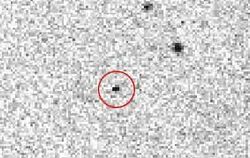Astronomy:Callirrhoe (moon)
 This discovery image of Callirrhoe taken by Spacewatch in October 1999 | |
| Discovery [2] | |
|---|---|
| Discovered by | Spacewatch[lower-alpha 1] |
| Discovery site | Kitt Peak National Observatory |
| Discovery date | 19 October 1999 |
| Designations | |
Designation | Jupiter XVII |
| Pronunciation | /kəˈlɪroʊiː/[3][4] |
| Named after | Καλλιρρόη Kallirrhoê |
| S/1999 J 1 1999 UX18 | |
| Orbital characteristics [5] | |
| Epoch 27 April 2019 (JD 2458600.5) | |
| Observation arc | 17.54 yr (6,406 days) |
| 0.1643278 astronomical unit|AU (24,583,090 km) | |
| Eccentricity | 0.3095704 |
| Orbital period | –787.43 d |
| Mean anomaly | 240.90203° |
| Mean motion | 0° 27m 25.866s / day |
| Inclination | 147.99790° (to ecliptic) |
| Longitude of ascending node | 352.75480° |
| 68.21981° | |
| Satellite of | Jupiter |
| Group | Pasiphae group |
| Physical characteristics | |
| Mean diameter | 9.6±1.3 km[6] |
| Albedo | 0.052±0.016[6] |
| Apparent magnitude | 20.8[7] |
| Absolute magnitude (H) | 13.9[5] |
Callirrhoe (/kəˈlɪroʊ.iː/; Greek: Καλλιρρόη), also known as Jupiter XVII, is one of Jupiter's outer natural satellites. It is an irregular moon that orbits in a retrograde direction. Callirrhoe was imaged by Spacewatch at Kitt Peak National Observatory from October 6 through November 4, 1999,[8] and originally designated as asteroid 1999 UX18.[9][10] It was discovered to be in orbit around Jupiter by Tim Spahr on July 18, 2000, and then given the designation S/1999 J 1.[2][11] It was the 17th confirmed moon of Jupiter.[8]
Name
It was named in October 2002 after Callirrhoe, daughter of the river god Achelous, one of Zeus' (Jupiter's) many conquests.[12]
Characteristics
Callirrhoe has an apparent magnitude of 20.7,[13] making it even fainter than dwarf planet Eris at magnitude 18.7.[14] Jupiter is about 2.5 billion times brighter than Callirrhoe.[15]
Callirrhoe is about 9.6 kilometers in diameter,[6] and orbits Jupiter at an average distance of 24.1 million kilometers in 747.09 days, at an inclination of 141° to the ecliptic (140° to Jupiter's equator) with an eccentricity of 0.28. This object was probably captured long ago from a heliocentric orbit and the Sun's gravitational influence makes this orbit highly erratic.[8]
It belongs to the Pasiphae group, irregular retrograde moons orbiting Jupiter at distances ranging between 22.8 and 24.1 million kilometers, and with inclinations ranging between 144.5° and 158.3°. However, while Pasiphae is gray (B−V=0.74, V−R=0.38, V−I=0.74) in color, Callirrhoe is light red (B−V=0.72, V−R=0.50, V−I=1.02) and more similar to Megaclite.[16]
Exploration

As a navigation exercise, the New Horizons spacecraft imaged Callirrhoe on January 10, 2007.[17]
Notes
References
- ↑ "Planet and Satellite Names and Discoverers". Gazetteer of Planetary Nomenclature. USGS Astrogeology Science Center. https://planetarynames.wr.usgs.gov/Page/Planets#JovianSystem. Retrieved 26 November 2020.
- ↑ 2.0 2.1 Brian G. Marsden (2000-07-20). "IAUC 7460: S/1999 J 1". IAU. http://www.cbat.eps.harvard.edu/iauc/07400/07460.html.
- ↑ Noah Webster (1884) A Practical Dictionary of the English Language
- ↑ "Pasiphae". Dictionary.com Unabridged. Random House. https://www.dictionary.com/browse/Pasiphae.
- ↑ 5.0 5.1 "M.P.C. 115890". Minor Planet Circular. Minor Planet Center. 27 August 2019. https://minorplanetcenter.net/iau/ECS/MPCArchive/2019/MPC_20190827.pdf.
- ↑ 6.0 6.1 6.2 Grav, T.Expression error: Unrecognized word "etal". (August 2015). "NEOWISE: Observations of the Irregular Satellites of Jupiter and Saturn". The Astrophysical Journal 809 (1): 9. doi:10.1088/0004-637X/809/1/3. 3. Bibcode: 2015ApJ...809....3G. https://authors.library.caltech.edu/61254/1/Grav_2015.pdf.
- ↑ Sheppard, Scott. "Scott S. Sheppard - Jupiter Moons". Department of Terrestrial Magnetism. Carnegie Institution for Science. https://sites.google.com/carnegiescience.edu/sheppard/moons/jupitermoons. Retrieved 26 November 2020.
- ↑ 8.0 8.1 8.2 "New Outer Satellite of Jupiter Discovered". Minor Planet Center. https://minorplanetcenter.net//iau/pressinfo/S1999J1.html. Retrieved 2009-07-23.
- ↑ "New moon of Jupiter found". SpaceFlight Now (University of Arizona News Release). http://spaceflightnow.com/news/n0007/21jovianmoon/. Retrieved 2009-07-23.
- ↑ MPS 7418 (Minor Planet Circulars Supplement); not available on-line
- ↑ MPEC 2000-Y16: S/1975 J 1 = S/2000 J 1, S/1999 J 1 2000-12-19 (discovery and ephemeris)
- ↑ IAUC 7998: Satellites of Jupiter 2002 October 22 (naming the moon)
- ↑ "Planetary Satellite Physical Parameters". JPL (Solar System Dynamics). 2009-04-03. http://ssd.jpl.nasa.gov/?sat_phys_par. Retrieved 2009-07-23.
- ↑ "AstDys (136199) Eris Ephemerides". Department of Mathematics, University of Pisa, Italy. https://newton.spacedys.com/astdys/index.php?pc=1.1.3.0&n=Eris. Retrieved 2009-03-16.
- ↑ (5th root of 100)^(20.7-(-2.8))=2.51 billion
- ↑ Grav, Tommy; Holman, M. J.; Gladman, B. J.; Aksnes, K. (2003). "Photometric survey of the irregular satellites". Icarus 166 (1): 33–45. doi:10.1016/j.icarus.2003.07.005. Bibcode: 2003Icar..166...33G.
- ↑ "New Horizons Jupiter Encounter Timeline". http://www.planetary.org/blogs/emily-lakdawalla/2007/jupiter_timeline.html.
External links
 |
